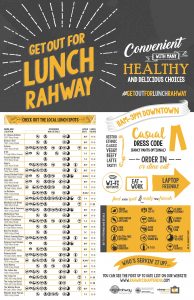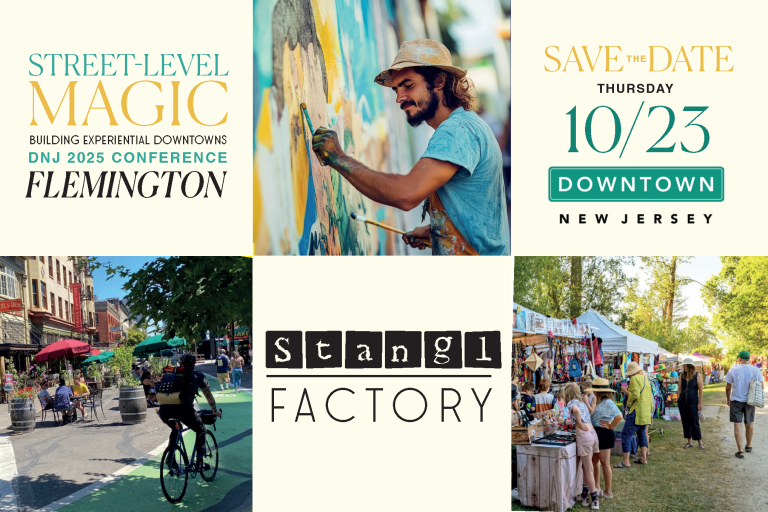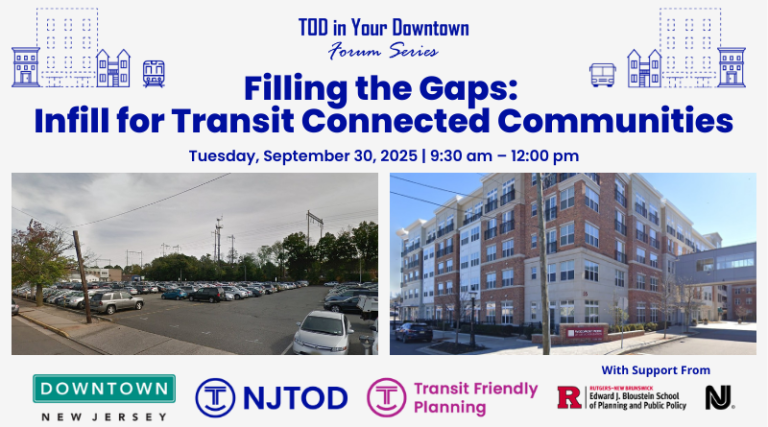Winter Downtown Management Round Table Recap
By Courtenay D. Mercer, PP, AICP
Executive Director, Downtown New Jersey
February 7, 2020
 More than 30 public officials, downtown managers, economic development directors and non-profit representatives gathered at round table discussion in East Orange on February 7th to exchange ideas about hot topics in downtown economic development. The discussion at this round table focused on developing and enhancing a downtown restaurant scene.
More than 30 public officials, downtown managers, economic development directors and non-profit representatives gathered at round table discussion in East Orange on February 7th to exchange ideas about hot topics in downtown economic development. The discussion at this round table focused on developing and enhancing a downtown restaurant scene.
To kick off the discussion, Emily Manz of EMI Strategy gave a brief overview of the restaurant industry in NJ. As of 2018, NJ offered 27,000 restaurants and quick service options. Restaurants provide over 330,900 jobs, or 8% of the state’s overall employment. Qualitatively, we know that restaurants bring people to our downtowns at different times of the day, contribute to an active street life, and shape the culture of a place.
Manz then opened discussion to attendees through a series of three questions. The discussion that followed is summarized below.
What types of programming, events, or marketing initiatives are you doing in your downtown to promote your restaurant community?
- A recent Crain’s NY article revealed that NYC BIDs are spending twice as much on marketing and events as they did a decade ago.
- In Rahway, the first time they did restaurant week, they did it in the Spring after their “Taste of Spring”. Based on feedback from restaurant owners, they moved the event to the winter when sales were typically lower. The event gained significant earned press, so they reduced the marketing budget for the following year. Unfortunately, the event was not as successful with the reduced marketing. The following year, they increased the marketing budget (including signage around town, table tents, press, etc.), and it was again a success. When reviewing their budget for the year, it includes some bread and butter events; but it is focusing more on beautification (planters, lighting, etc.). You have to carefully tread between what should be the responsibility of the BID versus the businesses versus the town.
- Denville has increased its event budget over the years. As events take up more budget and staff capacity, they too are weighing the best use of resources. Is it more important to so 10 events a year, or more business attraction activities? It is hard to stop an event once it starts. SOVCA agreed and has been having similar conversations about events.
- In East Orange, they are capitalizing on other people’s social capital to create buzz. “Going live” on social media has drawn attention to the downtown, and they are making strategic use of Facebook ads.
- Paterson agrees that social media provides low cost marketing opportunities. They fear that being too events/marketing driven detracts from quality of life concerns. They have been focusing on tangible improvements to create a clean and safe environment.
- Another attendee stated that it’s not either/or…both marketing and beautification are important.
- Often new administrations want to do more events and “make a splash”. The downtown manager needs to push back. Downtowns can lean into the non-profit world to program space and do events. In some towns, the Chamber of Commerce is a good organization to partner with.
- The Greater Newark Convention Bureau has been making use of hyper local billboards to attract residents downtown.
- According to Jon Schallert, a successful downtown needs to be programmed 200+ times a year. That programming does not all need to be done by the BID though. BIDs need to make sure the event aligns with overall goals. Does the event support or detract from existing businesses? Ideally, businesses would keep and share records of the income on normal day vs event, but it is hard or Mom & Pops to keep these records.
- Attendees asked Manz to provide additional information about the tours she runs in Newark, Bloomfield and Bound Brook. Tours provide an “experience”, which is highly sought after by Millennials. In general, NJ does not have a lot of tours – there is much room for growth. For her tours, Manz sells tickets and the participating restaurants get a portion of ticket take. The goal is for the tour attendees to meet the owner and feel a connection to the business. She recommends including four restaurants in a tour, but BIDs are typically looking to include seven or eight to gain more exposure. It is a balancing act between exposure and authenticity. It is important to include different types of restaurants. All are locally owned – giving the entrepreneur time to talk and welcome participants. EMI tours are typically 3 hours and cost $30/ticket.
- An attendee asked Manz who the target market was – residents or out of town? Manz noted that in Bound Brook, it is about half and half locals and surrounding towns. Regional tourism draw is important.

Rahway’s Get Out for Lunch Campaign
In Rahway, they have a campaign to target area employees to come out for lunch. They distribute rack cards to employers and around town that details restaurant offerings, including WiFi, client friendly, online ordering, vegan options, etc.
- In Newark, Audible requires a downtown tour for new employees, and they provide $15 to every employee for Lunch Out Wednesdays.
- In Scotch Plains, they held a “Pizza War” that included a film about local joints, followed by a contest to declare the best pizza in town.
What kinds of municipal policies or other changes at the municipal level can BIDS push to improve the environment for restaurants in downtowns?
- An attendee expressed that there is political resistance in their town to allow alcohol at outdoor seating.
- Group members suggested that a future DNJ article could focus on how outdoor dining benefits downtowns.
- Some things towns need to consider for outdoor seating:
- Is there enough sidewalk to accommodate throughput?
- What is an adequate level of insurance?
- Can restaurants use public space?
- If the town is doing a streetscape project, it should include accommodations for outdoor seating.
- Parklets are a good venue for outdoor dining. Towns should think about more centralized parking to replace parklet spaces.
- In Quebec City, for example, one restaurant/downtown district has a 15-minute maximum parking, and then roughly 30 spots accommodate parklet outdoor dining.
- In Copenhagen, some public spaces are used for communal dining experiences with shared wait staff and people can order from any number of adjacent restaurants.
- Parking is a perennial concern when discussing downtown business,
- In Rahway, they offer discount annual parking passes to central decks for employees. They have also experimented with valet parking.
- Parking in the street should be more expensive than parking in the deck.
- Reduce the allowed amount on time for on street parking.
- Often, government works slower than is reasonable for new retail and restaurant establishments (time is money).
- For events, many towns require too many permits – health, fire, police, etc. In Pompton Lakes, if the business is in town, they still have to apply for the permit, but they don’t have to pay the fee.
- BID managers can identify pinch points and work with local government to alleviate them.
- The Economic Development Committee in Princeton spearheaded a change in the permitting process, e.g., they had a minimum parking space requirement that they typically waive. Eliminating the requirement saved time and attorney fees.
- In Rahway, the economic development director holds the other departments accountable. They created a small business guide for new businesses. They also coordinate with realtors to make sure they know whether a space is zoned for a proposed use.
- We need to do a better job educating the business community about available resources. In Paterson, for example, the BID, UEZ, & Chamber each has different resources. It would be advantageous to streamline and have a one stop shop.
- A concern with food trucks is that they don’t pay into the BID, but the BID cleans up after them. In theory, the BID could receive a portion of the annual permit fee.
- Attendees discussed the concept of an “incubator” food truck program where a portion of the permit fee goes into a grant program to assist with the move from truck to brick and mortar.
How do BIDs attract restaurants/businesses to vacant spaces in their downtowns?
- Some BIDS engage in “smart retail recruitment”. Like a business in another community, recruit them to open second location in your downtown (especially if they already have 2 restaurants – they have experience with expansion).
- Educate prospects about what you have to offer downtown. Use existing business success as a recruitment tool.
- Chains can attract mom and pops around them.
- On average, downtown employees spend $60-$100 a year in the downtown. It’s important to know what you have and know what’s missing. Downtowns can’t survive just on weekend nights and brunch.
- The attendees generally agreed that NJ needs major Liquor license reform. NJ laws have not been substantially changed since the 1940s.
Overall, the round table was incredibly informative and great forum for sharing ideas and experiences. The next Downtown Management Round Table is May 8th at the offices of Gensler in Morristown, where Jonathan Tyler of Gensler will lead a discussion about retail strategies for your downtown, including experiential retail, retail as an amenity, and right-sizing retail. If you are interested in hosting a future round table, please contact DNJ Executive Director, Courtenay Mercer, at info(at)downtownnj.com or (201) 472-0356.




